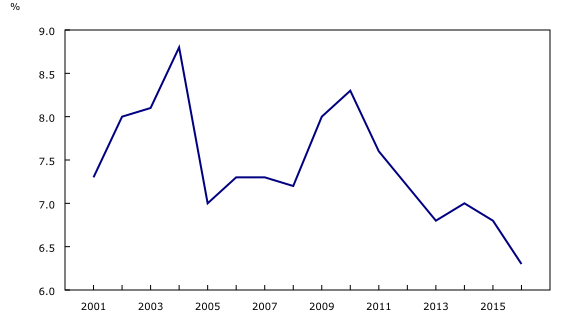Study: The transition from school to work – the not in employment, education or training (NEET) indicator for 15 to 19 year olds in Canada, 2016
Archived Content
Information identified as archived is provided for reference, research or recordkeeping purposes. It is not subject to the Government of Canada Web Standards and has not been altered or updated since it was archived. Please "contact us" to request a format other than those available.
Released: 2018-02-22
For a number of years, the Organisation for Economic Co-operation and Development (OECD) has released data on the proportion of youth who are not in employment, education or training (NEET). This is a closely followed indicator because NEET youth could be at increased risk of low income and social exclusion. However, these youth could be in a NEET situation for many different reasons, such as travelling, volunteering, providing community service or caring for children.
In Canada, the proportion of 15 to 19 year olds in NEET was 6.3% in 2016, representing around 127,000 individuals. This proportion has varied over time, from a high of 8.8% in 2004 to another peak of 8.3% in 2010. These peaks were the result of higher unemployment rates for non-students in this age group, of 23.5% in 2004 (during a period of economic slowdown for Canada) and 24.3% in 2010 (following the recession of 2008-2009). Unemployment rates for non-students in this age group have typically hovered around 20%.
More recently, the NEET rate for Canadians aged 15 to 19 has been steadily declining. This recent decline has occurred because of the increasing proportion of 15 to 19 year olds who were staying in school. For example, the percentage of youth in school rose from 79% in 2004 to 83% in 2016.
The NEET rate for 15 to 19 year olds differed by gender. In 2016, it stood at 7.2% for young men compared with 5.4% for young women. This difference was mostly due to two factors: young women were more likely to stay in school (85.4% of all young women aged 15 to 19, compared with 80.6% of all young men aged 15 to 19) and less likely to be unemployed (1.5% of all young women aged 15 to 19, compared with 3.6% of all young men aged 15 to 19).
Among OECD countries in 2016, the Canadian NEET rate for 15 to 19 year olds (6.3%) was fairly similar to the OECD average (6.1%). This rate varied widely among OECD countries, from a high of 18.4% in Turkey to a low of 2.1% in the Czech Republic. In the United States (7.3%), the rate was slightly higher than it was in Canada. In general, countries with a higher typical age of high school graduation tend to have lower NEET rates.
Products
The fact sheet "The transition from school to work – the NEET (not in employment, education or training) indicator for 15 to 19 year olds in Canada, 2016," which is part of the Education Indicators in Canada: Fact Sheet series (81-599-X), is now available online.
Contact information
For more information, or to enquire about the concepts, methods or data quality of this release, contact us (toll-free 1-800-263-1136; 514-283-8300; STATCAN.infostats-infostats.STATCAN@canada.ca) or Media Relations (613-951-4636; STATCAN.mediahotline-ligneinfomedias.STATCAN@canada.ca).
- Date modified:


